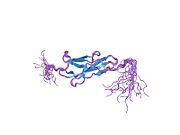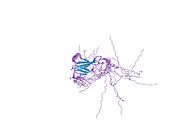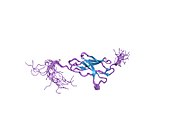SDK2
| SDK2 | |||||||||||||||||||||||||||||||||||||||||||||||||||
|---|---|---|---|---|---|---|---|---|---|---|---|---|---|---|---|---|---|---|---|---|---|---|---|---|---|---|---|---|---|---|---|---|---|---|---|---|---|---|---|---|---|---|---|---|---|---|---|---|---|---|---|
 | |||||||||||||||||||||||||||||||||||||||||||||||||||
| |||||||||||||||||||||||||||||||||||||||||||||||||||
| Identifiers | |||||||||||||||||||||||||||||||||||||||||||||||||||
| Aliases | SDK2, sidekick cell adhesion molecule 2 | ||||||||||||||||||||||||||||||||||||||||||||||||||
| External IDs | OMIM: 607217; MGI: 2443847; HomoloGene: 10406; GeneCards: SDK2; OMA:SDK2 - orthologs | ||||||||||||||||||||||||||||||||||||||||||||||||||
| |||||||||||||||||||||||||||||||||||||||||||||||||||
| |||||||||||||||||||||||||||||||||||||||||||||||||||
| |||||||||||||||||||||||||||||||||||||||||||||||||||
| |||||||||||||||||||||||||||||||||||||||||||||||||||
| Wikidata | |||||||||||||||||||||||||||||||||||||||||||||||||||
| |||||||||||||||||||||||||||||||||||||||||||||||||||
Protein sidekick-2 is a protein that in humans is encoded by the SDK2 gene.[5][6][7][8]
Function
The protein encoded by this gene is a member of the immunoglobulin superfamily.[7] The protein contains two immunoglobulin domains and thirteen fibronectin type III domains. Fibronectin type III domains are present in both extracellular and intracellular proteins and tandem repeats are known to contain binding sites for DNA, heparin and the cell surface. This protein, and a homologous mouse sequence, are very similar to the Drosophila sidekick gene product but the specific function of this superfamily member is not yet known. Evidence for alternative splicing at this gene locus has been observed but the full-length nature of additional variants has not yet been determined.[8]
References
- ^ a b c GRCh38: Ensembl release 89: ENSG00000069188 – Ensembl, May 2017
- ^ a b c GRCm38: Ensembl release 89: ENSMUSG00000041592 – Ensembl, May 2017
- ^ "Human PubMed Reference:". National Center for Biotechnology Information, U.S. National Library of Medicine.
- ^ "Mouse PubMed Reference:". National Center for Biotechnology Information, U.S. National Library of Medicine.
- ^ "OMIM: SIDEKICK CELL ADHESION MOLECULE 2; SDK2".
- ^ Yamagata M, Weiner JA, Sanes JR (Sep 2002). "Sidekicks: synaptic adhesion molecules that promote lamina-specific connectivity in the retina". Cell. 110 (5): 649–60. doi:10.1016/S0092-8674(02)00910-8. PMID 12230981. S2CID 7650760.
- ^ a b Yamagata, M. (2020). "Structure and Functions of Sidekicks". Frontiers in Molecular Neuroscience. 13: 139. doi:10.3389/fnmol.2020.00139. PMC 7479261. PMID 32982686.
- ^ a b "Entrez Gene: SDK2 sidekick homolog 2 (chicken)".
Further reading
- Yamagata M (2020). "Structure and Functions of Sidekicks". Frontiers in Molecular Neuroscience. 13: 139. doi:10.3389/fnmol.2020.00139. PMC 7479261. PMID 32982686.
- Kaufman L, Hayashi K, Ross MJ, Ross MD, Klotman PE (Jun 2004). "Sidekick-1 is upregulated in glomeruli in HIV-associated nephropathy". J Am Soc Nephrol. 15 (7): 1721–30. doi:10.1097/01.ASN.0000128975.28958.C2. PMID 15213259.
- Zody MC, Garber M, Adams DJ, et al. (2006). "DNA sequence of human chromosome 17 and analysis of rearrangement in the human lineage". Nature. 440 (7087): 1045–9. Bibcode:2006Natur.440.1045Z. doi:10.1038/nature04689. PMC 2610434. PMID 16625196.
- Gerhard DS, Wagner L, Feingold EA, et al. (2004). "The Status, Quality, and Expansion of the NIH Full-Length cDNA Project: The Mammalian Gene Collection (MGC)". Genome Res. 14 (10B): 2121–7. doi:10.1101/gr.2596504. PMC 528928. PMID 15489334.
- Ota T, Suzuki Y, Nishikawa T, et al. (2004). "Complete sequencing and characterization of 21,243 full-length human cDNAs". Nat. Genet. 36 (1): 40–5. doi:10.1038/ng1285. PMID 14702039.
- Strausberg RL, Feingold EA, Grouse LH, et al. (2003). "Generation and initial analysis of more than 15,000 full-length human and mouse cDNA sequences". Proc. Natl. Acad. Sci. U.S.A. 99 (26): 16899–903. Bibcode:2002PNAS...9916899M. doi:10.1073/pnas.242603899. PMC 139241. PMID 12477932.
- Nagase T, Kikuno R, Ishikawa K, et al. (2000). "Prediction of the coding sequences of unidentified human genes. XVII. The complete sequences of 100 new cDNA clones from brain which code for large proteins in vitro". DNA Res. 7 (2): 143–50. doi:10.1093/dnares/7.2.143. PMID 10819331.
- Nguyen DN, Liu Y, Litsky ML, Reinke R (1997). "The sidekick gene, a member of the immunoglobulin superfamily, is required for pattern formation in the Drosophila eye". Development. 124 (17): 3303–12. doi:10.1242/dev.124.17.3303. PMID 9310325.
- v
- t
- e
-
 1wf5: Solution structure of the first Fn3 domain of Sidekick-2 protein
1wf5: Solution structure of the first Fn3 domain of Sidekick-2 protein -
 1wfn: The fourth FN3 domain of human sidekick-2
1wfn: The fourth FN3 domain of human sidekick-2 -
 1wfo: The eighth FN3 domain of human sidekick-2
1wfo: The eighth FN3 domain of human sidekick-2 -
 1wis: Solution structure of the fifth FNIII domain from human KIAA1514 protein
1wis: Solution structure of the fifth FNIII domain from human KIAA1514 protein
 | This article on a gene on human chromosome 17 is a stub. You can help Wikipedia by expanding it. |
- v
- t
- e























